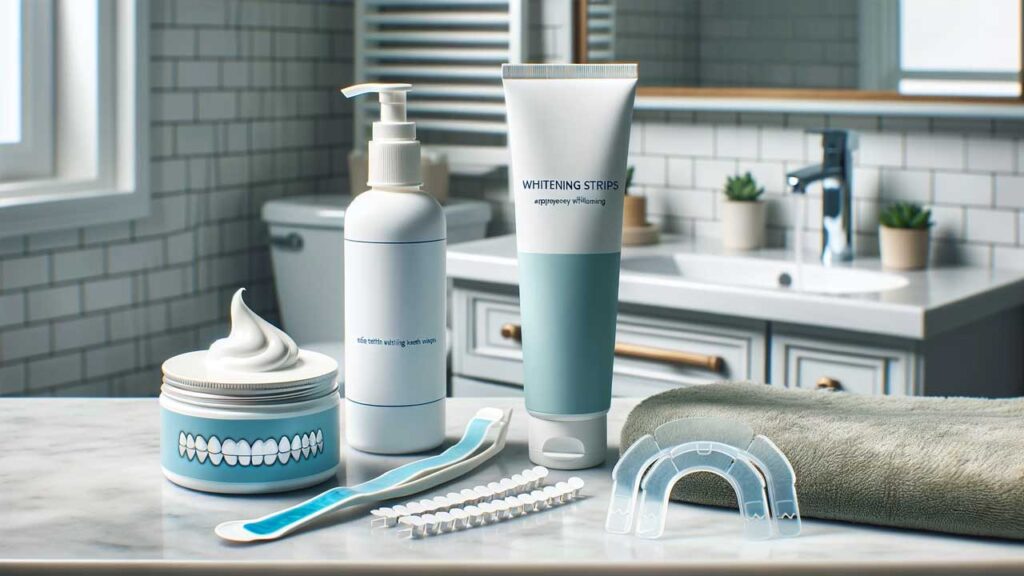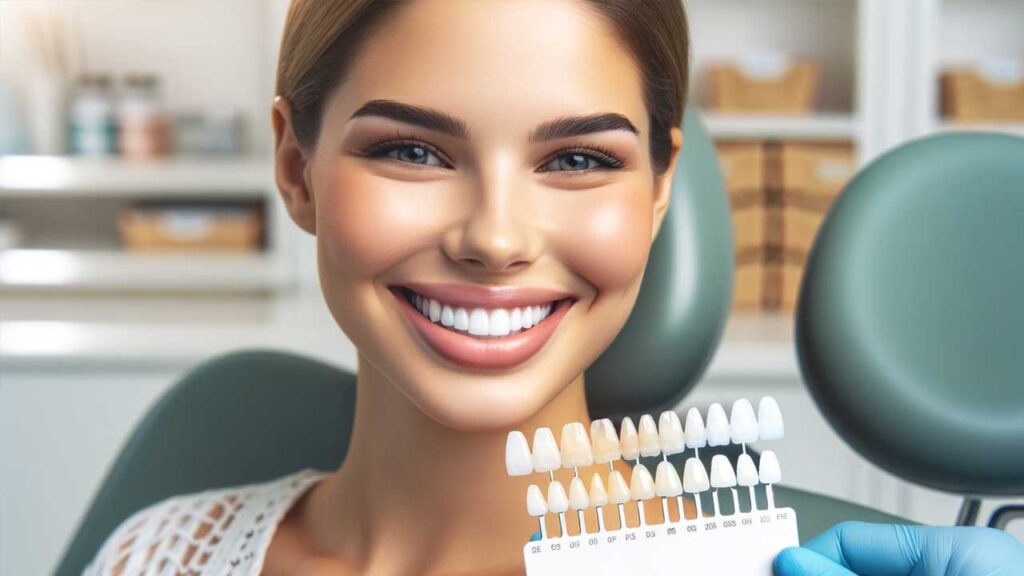Is teeth whitening safe? This question is at the forefront of many individuals looking to enhance their smiles through cosmetic dentistry. As the popularity of teeth whitening continues to soar, it’s essential to understand both its appeal and the safety concerns associated with it.
This article aims to explore the various facets of teeth whitening, offering insights into its safety, effectiveness, and the role it plays in cosmetic dentistry.
Is Teeth Whitening Safe? – A Brief Answer

In general, teeth whitening is considered safe when performed correctly, under professional guidance, or using approved at-home kits. However, understanding the process, potential side effects, and the right approach is crucial to ensure not just effective but also safe whitening results.
What is Teeth Whitening? Understanding the Basics
Teeth whitening, a segment of cosmetic dentistry, involves lightening and removing stains from teeth to enhance their appearance. This process can significantly improve the brightness and aesthetic appeal of one’s smile.
Different Types of Teeth Whitening Methods
Teeth whitening methods range from professional treatments in a dental office to at-home whitening kits. Professional procedures include laser whitening and bleaching with high-concentration peroxide gels, while at-home options involve lower-concentration bleach, whitening strips, or whitening toothpaste.
The Role of Cosmetic Dentistry in Teeth Whitening
Cosmetic dentistry plays a pivotal role in teeth whitening, offering both in-office and at-home solutions tailored to individual needs. Dental professionals assess tooth health, consider personal whitening goals, and recommend the most suitable method, ensuring safety and effectiveness.
Types of Teeth Whitening Methods and Their Safety Profiles
| Whitening Method | Safety Profile | Best For | Notes |
| Professional In-Office Whitening | High safety when performed by professionals | Deep stains, quick results | Requires dental supervision, more expensive |
| At-Home Custom Tray Kits | Generally safe with proper use | Moderate staining, gradual results | Customized to fit, less concentration than professional options |
| Over-the-Counter Strips and Gels | Safe when used as directed | Mild stains, maintenance | Widely available, varying effectiveness |
| Whitening Toothpaste | Safe for daily use | Surface stains, regular maintenance | Gentle, minimal whitening effect |
| Natural Whitening Methods | Varies (use caution) | Mild, natural approach | Non-chemical, effectiveness varies widely |
Note: It’s essential to follow product directions and consult a dental professional before starting any teeth whitening regimen, especially for individuals with sensitive teeth, gum disease, or dental restorations.
Safety in Professional Teeth Whitening: An In-Depth Look

Professional Whitening Techniques
Professional teeth whitening involves the application of high-concentration bleaching agents, such as hydrogen peroxide or carbamide peroxide, by dental professionals. Techniques may vary, ranging from traditional bleaching methods to advanced laser-assisted procedures, all performed under the supervision of a dentist.
Evaluating the Safety of Professional Teeth Whitening
When conducted by a qualified dental professional, teeth whitening is generally safe. Dentists take necessary precautions to protect the gums and oral tissues from the effects of bleaching agents. They also assess the health of your teeth and gums before the procedure, ensuring suitability for the treatment.
The Necessity of Dental Consultation
Consulting with a dentist is crucial for safe and effective professional teeth whitening. They can provide personalized advice based on individual oral health conditions, history of dental work, and specific whitening needs.
Safety Measures and Considerations in Professional Teeth Whitening
| Factor | Description | Importance |
| Dental Supervision | Procedures conducted by professionals | Ensures proper application and monitoring |
| Gum Protection | Use of barriers to protect gums from bleaching agents | Prevents irritation and burns |
| Personalized Treatment | Customized based on individual dental health | Addresses specific dental concerns |
| Follow-up Care | Post-whitening check-ups and guidance | Monitors oral health and maintenance |
| Professional Grade Products | High-quality, tested bleaching agents | Ensures safety and effectiveness |
Note: Always undergo a dental examination before engaging in professional teeth whitening to ensure it is a safe option for you.
Home Teeth Whitening Kits: Assessing the Risks and Benefits
Overview of Home Whitening Kits
Home teeth whitening kits come in various forms, including gels, strips, and custom-fitted trays. These products generally contain lower concentrations of bleaching agents compared to professional treatments and are designed for safe, at-home use.
Safety Evaluation of At-Home Products
Most at-home whitening kits are considered safe when used as directed. However, misuse or overuse can lead to sensitivity or damage to the teeth and gums. It’s important to follow the instructions carefully and consider consulting a dentist, especially for individuals with sensitive teeth or existing dental issues.
Home Kits vs. Professional Treatments: A Safety Comparison
While home kits offer convenience and affordability, professional treatments provide a safer and more controlled environment. The expertise of a dental professional ensures that the treatment is suitable for your teeth, and any potential issues are addressed promptly.
Comparison of Safety Features: Home Whitening Kits vs. Professional Treatments
| Feature | Home Whitening Kits | Professional Treatments |
| Bleaching Agent Concentration | Lower concentration, suitable for gradual whitening | Higher concentration, rapid results |
| Application Control | Self-applied, risk of incorrect usage | Applied by professionals, precise control |
| Gum Protection | Limited, depends on user application | Comprehensive, professional measures |
| Suitability Assessment | Self-assessed, potential for oversight | Conducted by dentist, thorough evaluation |
| Long-Term Safety | Varies, can cause sensitivity if misused | Generally safer, with follow-up care |
Note: It’s advisable to start with a dental consultation even when considering at-home whitening kits to ensure the best and safest outcome.
The Role of Bleaching Agents in Whitening Safety
Understanding Common Bleaching Agents
Bleaching agents like hydrogen peroxide and carbamide peroxide are the active ingredients in most whitening products. They work by breaking down stains on the tooth surface, resulting in a brighter appearance.
Safety Concerns with Different Concentrations
The concentration of bleaching agents plays a significant role in both effectiveness and safety. Higher concentrations offer quicker results but increase the risk of sensitivity and gum irritation. Lower concentrations are safer for at-home use but require a longer duration to achieve desired results.
Regulatory Standards for Whitening Products
Whitening products are subject to regulatory standards to ensure their safety and efficacy. These regulations govern the permissible concentration of bleaching agents and mandate clear labeling and instructions to guide consumers.
Potential Side Effects of Teeth Whitening
Common Side Effects and Their Prevalence
Teeth whitening, while generally safe, can have some common side effects. The most prevalent include tooth sensitivity and gum irritation. These side effects are typically temporary and subside a few days after the treatment. The intensity of these side effects varies based on the method used and the individual’s sensitivity.
Impact of Whitening on Long-term Oral Health
Concerns about the long-term oral health effects of teeth whitening revolve mainly around enamel damage and tooth sensitivity. However, when used appropriately and under professional guidance, teeth whitening products do not cause permanent damage to teeth or gums.
Managing and Preventing Side Effects
To manage and prevent side effects:
- Follow the product instructions and professional advice closely.
- Use toothpaste for sensitive teeth if experiencing discomfort.
- Avoid extremely hot or cold foods and beverages post-treatment.
- Consult a dentist if side effects persist or are severe.
Common Side Effects of Teeth Whitening and Preventive Measures
| Side Effect | Description | Preventive Measures |
| Tooth Sensitivity | Increased sensitivity to temperature | Use desensitizing toothpaste; reduce bleach concentration |
| Gum Irritation | Mild irritation of gum tissues | Ensure proper application; use lower concentration gels |
| Enamel Damage | Potential weakening of enamel with misuse | Follow recommended usage; avoid overuse of whitening products |
Note: Consult a dental professional if you experience prolonged or severe side effects.
Natural Teeth Whitening: Evaluating Safety and Effectiveness
Natural Whitening Methods Overview
Natural teeth whitening methods include using baking soda, hydrogen peroxide, fruit peels, and oil pulling. These methods are appealing to those seeking a more holistic approach and are generally considered safe when used correctly.
Comparing Safety: Natural vs. Chemical Methods
Natural methods are perceived as safer compared to chemical methods due to their gentle nature. However, they are often less effective, especially for deep stains or significant discoloration.
Realities and Myths of DIY Teeth Whitening
While some DIY methods can offer mild whitening effects, others are surrounded by myths and misinformation. For instance, lemon juice or apple cider vinegar might whiten teeth but can also erode enamel over time. It’s essential to research and consult a dentist before trying DIY methods.
Special Safety Considerations in Teeth Whitening
Whitening for Sensitive Teeth: Safety Tips
For those with sensitive teeth:
- Opt for lower concentration whitening agents.
- Use desensitizing toothpaste before and after whitening.
- Consider professional treatment to ensure safe application.
Guidelines for Teeth Whitening During Pregnancy
There is limited research on the effects of teeth whitening during pregnancy. As a precaution, it’s often recommended to avoid chemical whitening procedures during this period.
Age-Related Considerations in Teeth Whitening
Age plays a role in teeth whitening safety. For teenagers, whitening is generally safe under dental supervision. For older adults, considerations include the presence of restorations and the potential for increased sensitivity.
Long-Term Safety and Maintenance of Whitened Teeth
Ensuring Long-Term Oral Health Post-Whitening
Maintaining oral health after teeth whitening is crucial for the long-term safety and sustainability of the results. This includes adhering to good oral hygiene practices such as regular brushing and flossing, using mouthwash, and avoiding foods and drinks that can stain teeth.
Frequency of Safe Whitening Sessions
The frequency of whitening sessions should be carefully monitored to avoid overuse, which can lead to enamel damage and increased sensitivity. For professional whitening, it’s generally recommended to wait at least six months to a year between sessions. Home kits might require more frequent use but should be used as per the product guidelines or dental advice.
Importance of Post-Whitening Dental Care
Regular dental check-ups are vital to ensure the health of your teeth post-whitening. Dentists can provide professional cleanings to maintain the brightness of your teeth and monitor any potential side effects or issues related to the whitening process.
The Future of Teeth Whitening: Innovations for Safer Practices
Advances in Whitening Technologies and Safety
The field of teeth whitening is continually evolving, with advancements aimed at improving both safety and efficacy. Technologies such as LED lights and laser treatments are being refined to enhance the whitening effect while minimizing risks.
Anticipating Future Safety Standards in Whitening
As the industry grows, so do the efforts to ensure safety. Future safety standards in teeth whitening are expected to become more stringent, focusing on the ingredients used in whitening products and the protocols for their application.
Emerging Trends in Natural Whitening Methods
Natural whitening methods are gaining popularity as consumers seek safer and more environmentally friendly options. Innovations in this area include new herbal mixtures and improvements in existing natural remedies to enhance their whitening efficacy.
Professional Guidance for Safe Teeth Whitening
Seeking Expert Advice on Whitening Safety
Consulting with dental professionals is key to safe teeth whitening. They can provide personalized advice based on your oral health status and history, helping to choose the safest and most effective whitening method.
Personalized Plans for Safe Teeth Whitening
Dental professionals can develop personalized whitening plans that consider individual needs and sensitivities, ensuring both safety and effectiveness. These plans may include a combination of in-office treatments and at-home care.
The Role of Regular Dental Check-Ups
Regular dental check-ups play a crucial role in maintaining the health of your teeth after whitening. They help identify any potential issues early on and provide guidance on maintaining the results of the whitening treatment.
Expert Recommendations for Safe Teeth Whitening Practices
| Recommendation | Description | Importance |
| Dental Evaluation Before Whitening | Assess oral health to determine suitability for whitening | Prevents potential harm to teeth and gums |
| Following Product Instructions Carefully | Adhere to guidelines for at-home whitening kits | Reduces risks of misuse and side effects |
| Moderation in Whitening Frequency | Avoid over-whitening to protect enamel and reduce sensitivity | Ensures long-term oral health |
| Professional In-Office Whitening | Opt for supervised whitening for safer results | Provides expert application and monitoring |
| Regular Dental Check-Ups | Maintain oral health and monitor whitening effects | Essential for post-whitening care and maintenance |
Note: Following these expert recommendations can help ensure a safe and effective teeth whitening experience.
FAQ: Addressing Common Questions on Teeth Whitening Safety
Is Teeth Whitening Safe for Enamel Health?
Teeth whitening is generally safe for enamel health when used as directed. Most whitening products, especially those used in professional settings, are designed to be effective without damaging the enamel. However, overuse or misuse can lead to enamel erosion.
How Safe Are Home Teeth Whitening Kits Compared to Professional Treatments?
Home teeth whitening kits are safe when used according to the product instructions. They typically have lower concentrations of bleaching agents compared to professional treatments, making them less potent but also reducing the risk of side effects.
What Are the Common Side Effects of Dental Whitening?
The most common side effects of dental whitening include tooth sensitivity and gum irritation. These effects are usually temporary and subside within a few days post-treatment.
Are Over-the-Counter Teeth Whitening Products Safe to Use?
Over-the-counter teeth whitening products are generally safe for use. It is crucial to follow the instructions on the product label and not exceed the recommended usage to avoid potential side effects.
How Does Teeth Whitening Impact Gum Health?
If whitening products are applied improperly or in excess, they can cause gum irritation. Professional treatments often include protective measures to safeguard gum health, and it’s important to be cautious with home kits.
Natural Teeth Whitening Methods Versus Chemical-Based: Which Is Safer?
Natural teeth whitening methods are typically safer as they use gentler ingredients. However, they may be less effective compared to chemical-based methods. Both types should be used responsibly to avoid harm.
Can Teeth Whitening Cause Long-Term Oral Health Issues?
When used correctly, teeth whitening does not cause long-term oral health issues. It’s essential to follow professional advice and product instructions to ensure safety.
What Safety Precautions Should Be Taken for Sensitive Teeth During Whitening?
For sensitive teeth, use lower concentration whitening products, apply desensitizing toothpaste before and after treatments, and consider professional treatments to minimize discomfort.
How Often Can Teeth Whitening Be Done Safely?
The safe frequency of teeth whitening depends on the method used. Generally, professional treatments can be done once every 6-12 months, while at-home kits might require more frequent use.
Are Laser Teeth Whitening Treatments Safe for All Ages?
Laser teeth whitening is safe for adults but is not recommended for children or teenagers. Always consult a dental professional to determine the best whitening method for your age group.
Safety Guidelines for Using Teeth Whitening Strips Effectively
When using whitening strips, follow the product instructions, do not leave them on longer than recommended, and avoid swallowing the product to ensure safety.
Is Professional Teeth Whitening Recommended During Pregnancy?
Due to the lack of research, it’s generally advised to avoid professional teeth whitening during pregnancy as a precautionary measure.
In conclusion, teeth whitening is safe when the right products are used correctly and under professional guidance. It’s essential to understand the different methods and their potential side effects to make informed decisions.
To ensure safe teeth whitening, always follow product instructions, consult with dental professionals, and consider your oral health history and sensitivities. Regular dental check-ups post-whitening are also crucial.
A holistic approach to dental health involves balancing the desire for a brighter smile with the importance of maintaining overall oral health. This approach prioritizes safe practices and informed choices in the journey towards enhancing dental aesthetics.

